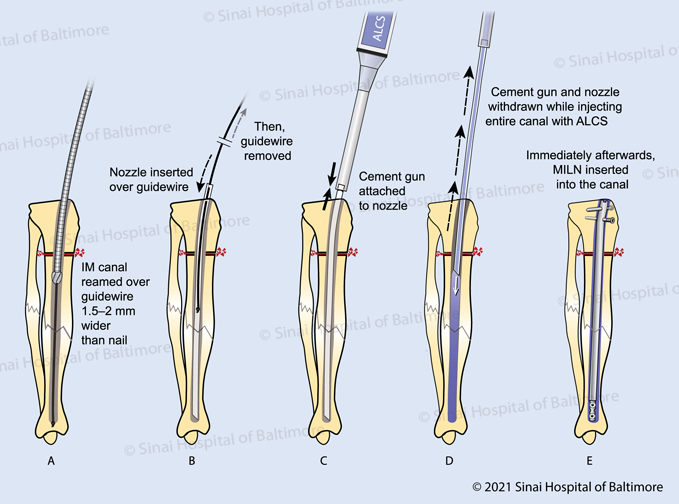Antibiotic-loaded Cement Spacer (ALCS) and Magnetic Internal Lengthening Nails (MILN) for Infection with Limb Length Discrepancy (LLD) or Nonunion
A possible solution to the challenging problem of long bone infection and limb length difference (LLD) can be addressed with the combined use of antibiotic-loaded cement spacer (ALCS) and magnetic internal lengthening nails (MILN). This technique can also be used for infected nonunions that require compression. Below are illustrations representing this combined technique for treating an infected tibial nonunion.
 A. After successful debridement, the intramedullary canal of the tibia was drilled slightly wider than the width of the internal lengthening nail. This allows for space for the ALCS to treat the bone surrounding the internal nail. B. The cement gun nozzle was inserted over a guidewire into the farthest (distal) portion of the bone so that it is positioned well past the tibial nonunion. Then, the guidewire was removed. C. The cement gun was filled with ALCS and attached to the exposed end of the nozzle. D. As the nozzle was slowly withdrawn, ALCS was injected along the length of the entire intramedullary canal. E. The nail was immediately inserted into the tibial intramedullary canal.
A. After successful debridement, the intramedullary canal of the tibia was drilled slightly wider than the width of the internal lengthening nail. This allows for space for the ALCS to treat the bone surrounding the internal nail. B. The cement gun nozzle was inserted over a guidewire into the farthest (distal) portion of the bone so that it is positioned well past the tibial nonunion. Then, the guidewire was removed. C. The cement gun was filled with ALCS and attached to the exposed end of the nozzle. D. As the nozzle was slowly withdrawn, ALCS was injected along the length of the entire intramedullary canal. E. The nail was immediately inserted into the tibial intramedullary canal.